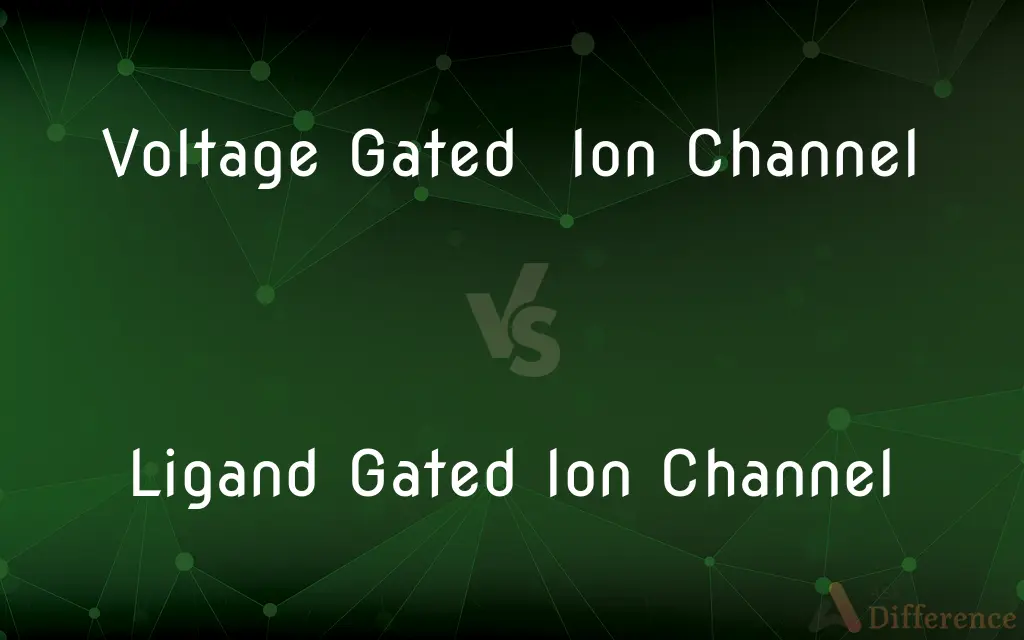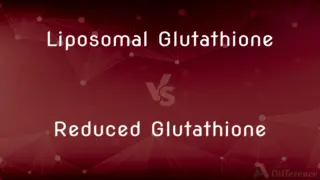Voltage Gated Ion Channel vs. Ligand Gated Ion Channel — What's the Difference?
By Tayyaba Rehman & Urooj Arif — Published on February 16, 2024
Voltage-gated ion channels open in response to changes in membrane potential, while ligand-gated ion channels open upon binding specific chemical messengers.

Difference Between Voltage Gated Ion Channel and Ligand Gated Ion Channel
Table of Contents
ADVERTISEMENT
Key Differences
Voltage-gated ion channels are integral membrane proteins that open or close in response to changes in the electrical membrane potential near the channel. These channels are crucial for the propagation of electrical signals in nerve and muscle cells. Ligand-gated ion channels, on the other hand, open in response to the binding of a specific neurotransmitter or other chemical messengers, allowing ions to pass through the membrane and alter the cell's electrical charge.
The operation of voltage-gated ion channels is essential for the rapid transmission of electrical signals along neurons, contributing to the generation of action potentials. This mechanism enables the nervous system to communicate quickly and efficiently. Ligand-gated ion channels are fundamental in synaptic transmission, where they translate chemical signals back into electrical ones, facilitating communication between neurons at synapses.
Voltage-gated ion channels are highly sensitive to the voltage across the cell membrane, with different channels responding to specific voltage changes. This specificity allows for precise control over the electrical properties of cells. Ligand-gated ion channels are sensitive to specific molecules, which can be neurotransmitters, hormones, or other signaling molecules, making them key components in various signaling pathways.
Both types of ion channels are critical for the physiological functions of cells. Voltage-gated ion channels play a key role in the heart's electrical activity, muscle contraction, and sensory processes. Ligand-gated ion channels are involved in processes such as learning, memory, and the regulation of muscle tone. Despite their different activation mechanisms, both channel types contribute to the complexity of cellular communication and function.
In summary, voltage-gated and ligand-gated ion channels are essential for cell signaling, each with distinct mechanisms of action. Voltage-gated channels respond to changes in membrane potential, while ligand-gated channels respond to chemical signals. Both are indispensable for the proper functioning of the nervous system, among other physiological processes.
ADVERTISEMENT
Comparison Chart
Activation Mechanism
Changes in membrane potential
Binding of specific chemical messengers
Location
Throughout the neuron, especially axons
Often located at synapses
Function
Propagation of electrical signals, action potentials
Synaptic transmission, modulation of electrical signals
Types of Signals Involved
Electrical
Chemical (neurotransmitters, hormones)
Physiological Role
Action potential generation, muscle contraction
Neurotransmission, synaptic plasticity
Compare with Definitions
Voltage Gated Ion Channel
Found in excitable cells like neurons and muscle cells.
Muscle contractions are controlled by the action of voltage-gated ion channels.
Ligand Gated Ion Channel
Involved in fast synaptic signaling in the nervous system.
Ligand-gated ion channels enable rapid responses to neurotransmitters.
Voltage Gated Ion Channel
Play a critical role in cellular communication.
Without voltage-gated ion channels, neurons could not transmit signals effectively.
Ligand Gated Ion Channel
Directly translate chemical signals into electrical changes.
Ligand-gated ion channels convert the chemical message of neurotransmitters into an electrical signal within the neuron.
Voltage Gated Ion Channel
Channels that open in response to changes in membrane potential.
The depolarization of the neuron activates voltage-gated ion channels to initiate an action potential.
Ligand Gated Ion Channel
Channels that open in response to the binding of a chemical ligand.
The binding of acetylcholine to ligand-gated ion channels causes them to open, allowing ions to flow.
Voltage Gated Ion Channel
Integral to the propagation of action potentials.
Voltage-gated ion channels rapidly open and close to allow the flow of ions across the cell membrane.
Ligand Gated Ion Channel
Crucial for synaptic transmission between neurons.
Neurotransmitters activate ligand-gated ion channels to propagate neural signals.
Voltage Gated Ion Channel
Sensitive to electrical signals.
Voltage-gated ion channels respond to even minor changes in the cell's membrane potential.
Ligand Gated Ion Channel
Can be activated by various signaling molecules.
Different ligand-gated ion channels are specific to neurotransmitters like GABA or glutamate.
Common Curiosities
What activates voltage-gated ion channels?
Voltage changes across the cell membrane activate voltage-gated ion channels.
What triggers ligand-gated ion channels to open?
The binding of specific chemical ligands (like neurotransmitters) triggers them to open.
How do ligand-gated ion channels influence learning and memory?
They are involved in synaptic plasticity, which is essential for learning and memory.
Are there diseases associated with malfunctioning voltage-gated ion channels?
Yes, conditions like epilepsy and cardiac arrhythmias can result from their malfunction.
What ions do voltage-gated ion channels typically allow through?
They typically allow Na+, K+, Ca2+, and Cl- ions through, depending on the channel type.
Do voltage-gated ion channels contribute to the heartbeat?
Yes, they play a crucial role in generating the heart's electrical rhythm.
How do voltage-gated ion channels affect action potential propagation?
They enable the rapid onset and propagation of action potentials along excitable cells.
Can ligand-gated ion channels detect hormones?
Yes, some ligand-gated ion channels can be activated by hormones.
Can drugs target ligand-gated ion channels?
Many drugs target these channels to modulate neural activity and treat various conditions.
Are ligand-gated ion channels important for muscle function?
Yes, especially in the context of neuromuscular junctions where muscle contraction is initiated.
What role do ligand-gated ion channels play in the nervous system?
They are key to neurotransmission and synaptic signaling within the nervous system.
Where are voltage-gated ion channels typically found?
They are commonly found in nerve and muscle cells.
How are voltage-gated and ligand-gated ion channels studied?
Researchers use electrophysiology, molecular biology, and pharmacology to study these channels.
Can the malfunction of ligand-gated ion channels lead to disease?
Yes, abnormalities can contribute to neurological disorders, including anxiety and schizophrenia.
What makes voltage-gated ion channels different from other ion channels?
Their unique sensitivity to changes in membrane potential distinguishes them from other types of ion channels.
Share Your Discovery

Previous Comparison
.38 Special vs. 9mm
Next Comparison
Liposomal Glutathione vs. Reduced GlutathioneAuthor Spotlight
Written by
Tayyaba RehmanTayyaba Rehman is a distinguished writer, currently serving as a primary contributor to askdifference.com. As a researcher in semantics and etymology, Tayyaba's passion for the complexity of languages and their distinctions has found a perfect home on the platform. Tayyaba delves into the intricacies of language, distinguishing between commonly confused words and phrases, thereby providing clarity for readers worldwide.
Co-written by
Urooj ArifUrooj is a skilled content writer at Ask Difference, known for her exceptional ability to simplify complex topics into engaging and informative content. With a passion for research and a flair for clear, concise writing, she consistently delivers articles that resonate with our diverse audience.













































